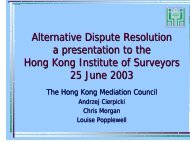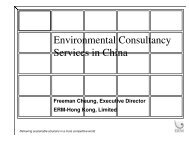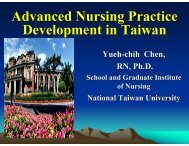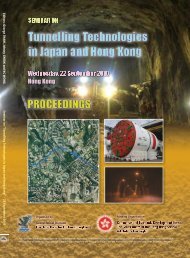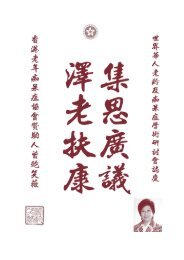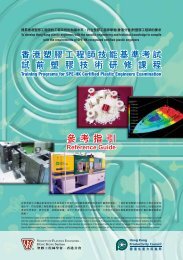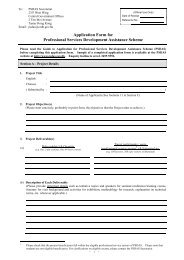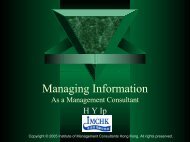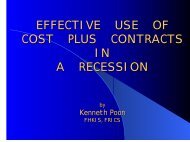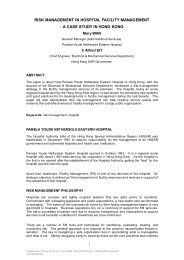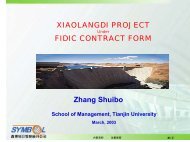Universal vs high risk screening
Universal vs high risk screening
Universal vs high risk screening
You also want an ePaper? Increase the reach of your titles
YUMPU automatically turns print PDFs into web optimized ePapers that Google loves.
Neonatal Hearing Screening-<br />
<strong>Universal</strong> <strong>vs</strong> High Risk Screening-<br />
Experience in HK<br />
Dr. Barbara CC Lam<br />
Consultant<br />
Honorary Clinical Associate Professor<br />
Department of Paediatrics and<br />
Adolescent Medicine<br />
Queen Mary Hospital<br />
8 October 2005
Introduction<br />
• Severe congenital hearing impairment<br />
(HI) is an important handicap affecting<br />
1-3 per 1,000 live birth<br />
• The prevalence of moderate to profound<br />
hearing loss was 2 - 4 % of NICU infants<br />
• Infants with <strong>risk</strong> factors accounts for less<br />
than ~ 50% of cases<br />
• ~ 165 infants per year are born with<br />
significant HI in HK per year
Hearing is an important sensory input<br />
• Auditory stimulus perceives in the first<br />
few months of life forms the basis of<br />
speech, linguistics and cognitive<br />
development<br />
• The language ability, the social,<br />
emotional, comprehensive and motor<br />
development of HI are adversely affected
Early Intervention Improves Outcome<br />
• Yoshinaga-Itano showed age of the diagnosis of<br />
HI was the only significant variable to affect<br />
the language skill of HI child.<br />
• Several prospective studies showed that the<br />
prognosis for intellectual, language and speech<br />
development in the HI child can be improved<br />
significantly when the diagnosis is made early<br />
and intervention begins before 6 month of age<br />
• The first year of life, especially the first 6<br />
months is most critical<br />
Robinshaw 1995 Apuzzo & Yoshinaga-Itano 1995<br />
Moeller 1996 & Yoshinaga-Itano 1998
Past Situation in Hong Kong<br />
• Since 1978, Maternal and Child Health Centre<br />
(MCHC) provide ‘universal’ hearing <strong>screening</strong><br />
using Behavioural Distraction Test for infants<br />
around 6-9 months<br />
• Most HA birthing hospitals perform hearing<br />
test (BAEP) for <strong>high</strong> <strong>risk</strong> infants<br />
• The usual age at diagnosis of hearing<br />
impairment especially for those without <strong>risk</strong><br />
factors is usually at 2 year and most infants<br />
receive treatment and education after 2 years
Recent Change in Hong Kong<br />
• Most realized the importance of early diagnosis<br />
and early intervention<br />
• Some HA birthing hospitals pilot UNHS<br />
• Maternal and Child Health Centre (MCHC)<br />
replace the distraction test by Infant Hearing<br />
<strong>screening</strong> ( AOAE) for babies registered before 2<br />
months through the early infant hearing &<br />
surveillance programme since Aug 2003<br />
• There is a lack of a coordinated territory wide<br />
policy on hearing <strong>screening</strong> and the lack of<br />
territory wide registry with tracking and<br />
monitoring system
What is the most appropriate<br />
and cost effective newborn<br />
hearing <strong>screening</strong> programme<br />
for Hong Kong ?
Newborn Hearing Screening<br />
Strategies<br />
• High <strong>risk</strong> <strong>screening</strong><br />
• <strong>Universal</strong> <strong>screening</strong>
High Risk Indicators<br />
America Academy of Paediatrics Joint<br />
Committee on Infants Hearing 1990<br />
1. Family history of HI<br />
2. Congenital infection<br />
3. Craniofacial anomalies<br />
4. Low Birth weight (1500 grams or less)<br />
5. Severe neonatal jaundice
High Risk Indicators<br />
6. Ototoxic medications in toxic range<br />
7. Bacterial meningitis<br />
8. Severe depression at birth<br />
9. Mechanical ventilation for or > 5 days<br />
10. Syndrome known to include<br />
sensorineural and/or conductive<br />
hearing loss
High Risk Screening<br />
• ~ 5 - 10% of all babies born will exhibit<br />
one or more of these indicators<br />
• 2.5 - 10% of these infants confirmed to<br />
have permanent congenital hearing<br />
impairment (PCHI)<br />
• At least 50% of infants with PCHI do not<br />
have any of the <strong>risk</strong> factors
High Risk Multicentre Hearing<br />
Screening 1 year Project in HK<br />
1999-2000<br />
• Multicentre project involving 5 HA hospitals<br />
• Two stage distortion products OAE<br />
• Conventional auditory brainstem response for<br />
failed <strong>screening</strong> and babies with neurological<br />
abnormalities<br />
Chan KY et al<br />
(Sponsored by The Save Children Fund(HK)
Protocol of High Risk Infant<br />
Screening Project<br />
High Risk Infants<br />
OAE (14-28 days)<br />
Family history, asphyxia,<br />
meningitis, NNJ, congenital<br />
infection, PPHN etc<br />
N<br />
Abn<br />
Repeat OAE (
Summary of High Risk Infant<br />
Live Birth 19,922<br />
Screening Result<br />
Risk Factor 546 ( 2.7%)<br />
OAE 533 ( 97%)<br />
2nd OAE 70<br />
failed<br />
ABR 46 ( 8.6%)<br />
failed<br />
ENT 30<br />
*Hearing Loss 22 ( 4%)<br />
Default 13 (2.4%)<br />
CNS <strong>risk</strong> Additional<br />
ABR 210 ( 39%)<br />
Pass OAE but failed<br />
ABR - 13<br />
ENT 13<br />
Default 54<br />
* Hearing Loss 2 ( 0.3 %)
Distribution of Risk Factors
Multicentre High Risk Infants<br />
Hearing Screening Project<br />
1. 1.2 per thousand (24 out of 19,922 LB) have<br />
HI - <strong>high</strong> <strong>risk</strong> approach detect less than 50%<br />
of cases<br />
2. 2.4% of at <strong>risk</strong> infants have moderate to<br />
profound HI<br />
3. HI infants were identified before age 4-6<br />
months and all of them had received<br />
appropriate intervention before age of 9<br />
months
Multicentre High Risk Infants<br />
Hearing Screening Project<br />
4. OAE may miss some case with CNS defects<br />
5. No significant HI was detected at age 9<br />
months in those infants who passed<br />
newborn <strong>screening</strong><br />
6. Default rate for OAE is 2.4%, for ABR for<br />
those with CNS <strong>risk</strong> factors is 26% -<br />
<strong>screening</strong> best to be performed before<br />
hospital discharge & coupled with a robust<br />
tracking system
Criteria for Public Health<br />
<strong>Universal</strong> Screening:-<br />
1. Easy-to-use screen tests - <strong>high</strong> sensitivity to<br />
minimize unnecessary referrals<br />
2. The condition being screened for is not<br />
otherwise detectable by clinical means<br />
3. Interventions are available to correct the<br />
condition once detected<br />
4. Early <strong>screening</strong>, detection, and intervention<br />
result in improved outcomes<br />
5. The <strong>screening</strong> program is documented to be<br />
in an acceptable cost-effective range
<strong>Universal</strong> Newborn Hearing Screening<br />
• Congenital Hearing Loss fulfills the<br />
established Criteria for <strong>Universal</strong><br />
Screening<br />
• A universal newborn hearing <strong>screening</strong><br />
with a coverage rate of more than 95% is<br />
a more vigorous approach to achieve the<br />
aim of identifying most, if not all babies<br />
with congenital hearing loss at an early<br />
age to enable timely habilitation
<strong>Universal</strong> Newborn Hearing Screening<br />
• Hospital based <strong>vs</strong> Community based?<br />
• Which <strong>screening</strong> tools ?<br />
– AABR ? OAE ? OAE and AABR
UNHS Projects in Hong Kong<br />
I. First Pilot hospital based UNHS - 2 stage<br />
OAE ( TYH)- 1999<br />
II. Multicentre hospital based UNHS -<br />
Comparing different <strong>screening</strong> devices and<br />
protocols - 2001<br />
III. Pilot study of Community based UNHS by 2<br />
stage OAE in 4 MCHC -2001<br />
IV.<br />
Regional UNHS -2 stage AABR and cost<br />
effectiveness study – 2003-2005
Pilot UNHS- 2 stage OAE in TYH<br />
OAE Screen OAE Screen OAE Screen<br />
Day 1-4 Day 5-14 Day 21-30<br />
Infants 806 913 872<br />
Screened<br />
Failure 59% 21% 3.9%<br />
Rate<br />
PK Ng, Y Hui, BCC Lam et al HK Medical Journal 2004
Pilot UNHS- 2 stage OAE in TYH<br />
• Bilateral hearing loss is 0.28<br />
• High parental acceptance of UNHS – Coverage<br />
rate is 99.3%<br />
• Unacceptably <strong>high</strong> false positive rate ( 20%) in<br />
first 2 week due to ear debris<br />
• Refer rate for diagnostic audiological test is 3.5%<br />
PK Ng, Y Hui, BCC Lam et al HK Medical Journal 2004
Questionnaires study on Parental<br />
Acceptance of Newborn Hearing Screening<br />
• 91% consider newborn hearing <strong>screening</strong><br />
desirable<br />
• 82% favor pre-discharge <strong>screening</strong><br />
• 56% do not have a sound knowledge on<br />
hearing developmental milestone, undesirable<br />
to rely on parental self surveillance to detect HI<br />
in their babies<br />
PK Ng, Y Hui, BCC Lam et al HK Medical Journal 2004
Hospital based Multi-centre UNHS –<br />
Screening Device and Protocol<br />
• 3 different <strong>screening</strong> protocols<br />
– 2-stage AABR (Algo model 2e Color<br />
Newborn Screener)<br />
– 2-stage AABR (Biologic 2 in 1 screener)<br />
– 2 stage OAE-AABR (Biologic 2 in 1 screener)<br />
• Pre-discharge <strong>screening</strong>
Hospital based UNHS- Comparisons<br />
for 3 Different Screening Protocols<br />
BWY Young, BCC Lam CM Wong et al 2002<br />
AABR- OAE- ABear-<br />
AABR(Algo) ABear ABear( Bio)<br />
Failed first Test 5.3% 29.1% 15.1%<br />
Final Refer Rate 0.6% 5.0% 3.8%<br />
Average Screening 11 11 17.5<br />
Time (min.)<br />
Disturbance score 1.2±1.7 0 ±0.7 1.5 ±1.8
Hospital-based Multicentre UNHS<br />
BWY Young, BCC Lam CM Wong et al 2002<br />
• High coverage rate of 95% - UNHS is feasible<br />
before discharge from birthing hospital<br />
• The 2 stage AABR <strong>screening</strong> yielded the lowest<br />
refer rate - 0.6%<br />
• The time spent in the 3 <strong>screening</strong> methods are<br />
comparable<br />
• OAE <strong>screening</strong> cause the least disturbance to<br />
the babies, followed by AABR
Pilot Study of Community Based<br />
UNHS in MCHC<br />
KY Chan, SSL leung HKJ Paedatr 2004<br />
• 4 MCHC in August 2000 to July 2001<br />
• Infants with first MCH attendance at 2<br />
weeks to 2 months<br />
• 2 Stage OAE, re-screened 2 weeks later if<br />
failed the first <strong>screening</strong>
Pilot Study of Community based<br />
UNHS in MCH<br />
• Uptake rate 77% of attendees at MCH<br />
• Overall coverage rate not known<br />
• Failure rate: 2nd screen 3.8%<br />
• Out of 3,949 screened, 4 cases of Bilateral HI -<br />
1 per 1000 babies<br />
• Mean age of HI identification 85 days (<strong>vs</strong> 9-12<br />
month for distraction test)<br />
KY Chan, SSL leung HKJ Paedatr 2004
QMH & PYNEH<br />
<strong>Universal</strong> Newborn Hearing<br />
Screening<br />
A regional 2-stage AABR and cost<br />
effective analysis
UNHS Screening Protocol - 2-stage AABR – AABR<br />
All babies born in QMH<br />
& PYNEH<br />
No<br />
Distribute information sheet<br />
when baby is stable and >35 weeks<br />
Stable<br />
and >35<br />
weeks<br />
Yes<br />
Distribute information sheet<br />
on the first day of life<br />
Pass<br />
1st AABR<br />
<strong>screening</strong><br />
Fail<br />
Fail<br />
1st AABR<br />
same / next day<br />
after newborn<br />
examination<br />
Pass<br />
2nd AABR<br />
Screening on the<br />
same / next day<br />
Pass<br />
Discharge and encourage to<br />
attend MCHC for on going<br />
surveillance<br />
Fail
UNHS Screening protocol - 2-stage AABR – AABR<br />
Counseling by Paediatrician<br />
Refer to audiologist for diagnostic BAER<br />
Paediatric follow-up appointment 4 weeks later<br />
Diagnostic<br />
BAER<br />
Fail<br />
Pass<br />
Follow-up once<br />
by paediatrician<br />
Follow-up by<br />
paediatrician<br />
Follow-up by<br />
ENT Surgeon<br />
Refer to Special<br />
Education Unit for<br />
early habilitation
Can be used in Nursery<br />
Environment ( 5-20 min)
UNHS- QMH & PYNEH<br />
2 stage AABR- 2003-2005<br />
Total birth 14,604<br />
Babies screened 14,560<br />
Coverage rate 99.7%<br />
Failed 2nd screen 1.5%<br />
Confirmed HI 76 (0.5%)<br />
Bilateral HI 36<br />
Unilateral HI 40
UNHS- QMH & PYNEH<br />
2 stage AABR- 2003-2005<br />
Time Median<br />
1st <strong>screening</strong> 22 hrs<br />
2nd <strong>screening</strong><br />
41 hrs<br />
Diagnostic BAER<br />
43 days<br />
ENT<br />
66 days<br />
Special ed.<br />
158 days<br />
Hearing aid<br />
198 days
Recommended Parameters<br />
for Effective UNHS<br />
Parameters Study AAP<br />
High Coverage Rate 99.7% ≥ 95%<br />
Good Sensitivity (RR) 1.5% ≤ 4%<br />
Zero false negative √<br />
Bilateral HL ≥ 35dB √<br />
Before discharge √<br />
√<br />
√<br />
√
Cost<br />
No. Per baby Cost Average<br />
cost/birth<br />
Equipment 2 109,161 18<br />
Staff hours 5,098 20 min. 130-105/hr 40<br />
Consumable 3,028 0.25 75 12<br />
$<br />
Total 70
UNHS: Cost Analysis<br />
• Capital cost of equipment<br />
• Manpower & consumable cost<br />
• Cost for confirmatory test<br />
• Life long quality of life<br />
• Differences in life-time learning<br />
capabilities<br />
• Education cost
Long term Cost analysis<br />
Yea<br />
r<br />
Capital cost<br />
$<br />
Annual<br />
Recurrent<br />
cost<br />
$<br />
Additional<br />
Education cost<br />
(EETC)<br />
$<br />
Cumulative<br />
cost<br />
$<br />
Cumulative<br />
Education<br />
Savings<br />
$<br />
Cost<br />
(-spending/<br />
+saving)<br />
$<br />
1 1,228,500 5,440,758 2,581,508 9,250,766 / -9,250,766<br />
2 / 5,440,758 7,744,523 22,436,047 / -22,436,047<br />
3 / 5,440,758 7,744,523 35,621,328 / -35,621,328<br />
4 / 5,440,758 7,744,523 48,806,609 / -48,806,609<br />
5 / 5,440,758 7,744,523 61,991,890 / -61,991,890<br />
6 / 5,440,758 7,744,523 75,177,171 8,199,565 -66,977,606<br />
7 / 5,440,758 7,744,523 88,362,452 24,598,695 -63,763,757<br />
8 / 5,440,758 7,744,523 101,547,733 49,197,390 -52,350,343<br />
9 / 5,440,758 7,744,523 114,733,014 81,995,650 -32,737,364<br />
10 / 5,440,758 7,744,523 127,918,295 122,993,475 -4,924,820<br />
11 / 5,440,758 7,744,523 141,103,576 172,190,865 +31,087,289
Cost Effectiveness<br />
• Long term cost analysis showed that<br />
the cost of UNHS could be offset by<br />
savings from reduced burden on<br />
special education<br />
• Positive gain at 10-11 years after<br />
implementation.
Hospital <strong>vs</strong> Community Based<br />
- Coverage Rate<br />
Hospital based:<br />
TYH 2 stage OAE<br />
98.9% LB<br />
QMH PYNEH 2 stage AABR 99.7%<br />
MCH based:<br />
Distraction test<br />
60% at 9M<br />
2 Stage OAE 72% of all<br />
attendees
Hospital <strong>vs</strong> Community Based<br />
High Sensitivity<br />
• Recommended parameter - Refer rate for<br />
diagnostic test Target < 4%<br />
• Refer rate for diagnostic test<br />
– Hospital based AABR program 1.5%<br />
– MCH based OAE program 3.8%
Hospital <strong>vs</strong> Community Based -<br />
Early Referral<br />
• Recommended Parameter - Target 100%<br />
before 3 months or shortly after birth<br />
• Mean age of referral for diagnostic test<br />
– Hospital based AABR program - 41hours<br />
– MCHC based OAE program - 54 days
Hospital <strong>vs</strong> Community Based -<br />
Parental Acceptance<br />
• Screening test is completed before<br />
discharge<br />
• Child back to China<br />
• High parental satisfaction<br />
• Less anxiety due to lower and earlier<br />
referral for diagnostic test
Hospital VS Community Based<br />
Cost Analysis<br />
Hospital based AABR MCH based OAE<br />
8 centres ($M) 44 centres ($M)<br />
Capital cost 1.2 3.2<br />
of equipment<br />
Annual labour cost 2.38 2.83<br />
Annual consumables 2.5 0.8<br />
Cost of diagnostic test 0.5 12<br />
Cost per deaf child 0.33 0.95<br />
identified
Available Supporting Facilities!<br />
• Hospital based UNHS<br />
– Available specialist support and<br />
expertise including audiologist,<br />
paediatrician and ENT surgeon for<br />
counseling and further audiological<br />
evaluation
<strong>Universal</strong> Hospital Based Predischarge<br />
Newborn Hearing should be Introduced<br />
• Efficacy of a <strong>screening</strong> program<br />
Maximal coverage<br />
Good sensitivity (low refer rate)<br />
High specificity (low false negative rate)<br />
High patient acceptance<br />
Cost effective
The Way Forward -<br />
Collaborative model<br />
Combine the specific competencies of the 2<br />
involved parties
Role of Community Centre<br />
• Establish and maintain a central registry<br />
and monitoring system<br />
• Establish and maintain a tracking<br />
program that monitor all referrals and<br />
miss<br />
• To provide mop up service for out-ofhospital<br />
births<br />
• Ongoing surveillance for late onset<br />
hearing impairments
Summary<br />
• Our UNHS studies demonstrated<br />
comparable incidence of HI among<br />
local infants at 3 to 5 per thousand<br />
• A hospital based UNHS ensure <strong>high</strong><br />
coverage and early detection<br />
• 2 stage AABR achieve a low refer<br />
rate , <strong>high</strong> parental acceptance at an<br />
acceptable costs
Summary<br />
• Newborn hearing <strong>screening</strong> program<br />
– Good <strong>screening</strong> method<br />
– Tracking and follow up system<br />
– Early identification and intervention<br />
– Ongoing evaluation for late onset HI<br />
• A territory wide hospital based UNHS<br />
should be implemented to enable early<br />
detection and intervention leading to<br />
improved language and learning outcome<br />
in HI children
Acknowledgement<br />
• HA High Risk Infants<br />
Hearing Screening Program<br />
– CB Chow<br />
– KY Chan<br />
– B CC Lam<br />
– W Wong<br />
– TF Fok<br />
– CW Law<br />
– WH Lee<br />
– KC Wong<br />
– KN Yuen<br />
– CC Shek<br />
– E Wong<br />
• Multicentre <strong>Universal</strong><br />
Newborn Hearing Project<br />
– B Young<br />
– BCC Lam<br />
– Y Hui<br />
– E Wong<br />
– W Yeung<br />
– T Wong<br />
– M Tong<br />
– CB Chow<br />
– W Wong<br />
– P Chan
Acknowledgement<br />
• TYH pilot universal<br />
newborn hearing<br />
<strong>screening</strong><br />
– P K Ng<br />
– Barbara Lam<br />
– C Y Yeung<br />
– Winnie Goh<br />
– Yau Hui<br />
• QMH & PYNEH<br />
Regional UNHS<br />
– BWY Young<br />
– BCC Lam<br />
– W Yeung<br />
– Y Hui<br />
– D Au
Thank You !
Risk Indicates for Infants with Late<br />
Onset/Progressive Hearing Loss<br />
• Neonatal <strong>risk</strong> factors including hyperbilirubinemia<br />
requiring exchange transfusion<br />
• Syndromes associated with hearing loss such as<br />
Usher’s syndrome<br />
• Neurodegenerative disorders such as Friedreich’s<br />
ataxia<br />
• Head trauma<br />
• Recurrent persistent otitis media with effusion for<br />
more than three months
Risk Indicates for Infants with Late<br />
Onset/Progressive Hearing Loss<br />
• Caregiver concern about hearing, speech or<br />
language and/or developmental delay<br />
• Family history of permanent hearing loss<br />
• Stigmata associated with permanent hearing loss<br />
• Postnatal infections associated with hearing loss,<br />
such as bacterial meningitis<br />
• In-utero infections including cytomegalovirus,<br />
herpes, rubella, syphilis, and toxoplasmosis
Recommended Parameters of an Effective<br />
UNHS Program<br />
- JCIH 2000 Position Statement<br />
1. Screening<br />
2. Tracking and Follow Up<br />
3. Identification and Intervention<br />
4. Evaluation
Current Recommendation on<br />
Hearing Loss<br />
1. <strong>Universal</strong> detection of hearing loss in infants<br />
before 3 months<br />
2. Appropriate intervention no later than 6<br />
month<br />
3. Targeted at permanent bilateral or unilateral,<br />
sensory or conductive hearing loss, average<br />
30-40 dB or more in the frequency region<br />
important for speech recognition
Current Recommendation on<br />
Hearing Loss<br />
4. Infants who pass NHS, but have <strong>risk</strong><br />
indicators for auditory disorders should<br />
receive ongoing audiologic and medical<br />
surveillance and monitoring for 3 years<br />
5. Infants and family rights are<br />
guaranteed through informed choice,<br />
decision marking and consent
JCIH Recommends Benchmarks for<br />
Screening, Identification and Intervention<br />
• Within 6 months of initiation of a <strong>screening</strong><br />
program must screen a minimum of 95% of<br />
infants during birth admission or before 1 month<br />
of age<br />
• Referral rate for audiologic and medical<br />
evaluation after <strong>screening</strong> should be 4% or less<br />
within 1 year of the programme<br />
• Document efforts to follow up on 95% of infants<br />
who do not pass the screen and actual FU of 70%<br />
or more of infants
More Cost Effective !<br />
Cost Analysis- Assumptions<br />
• Annual livebirths in HK 55,000<br />
• Annual livebirth in HA hospitals = 40,000<br />
• Private hospitals provide their own UNHS service<br />
• Incidence of PCHI = 3 per 1,000 livebirths<br />
• Annual PCHI cases = 165<br />
• No. of MCHC providing hearing <strong>screening</strong> service<br />
= 42 out of the 50 MCHCs<br />
• No. of birthing hospitals in HK = 9<br />
• Gazette cost of ABR = $1,600
Recommended Parameters of an Effective UNHS<br />
Program - JCIH 2000 Position Statement<br />
1) Screening<br />
– Testing both ears, with a minimum of 95%<br />
coverage rate<br />
– Able to detect significant bilateral HL of ≥ 35<br />
dB in the better ear<br />
– Low false-positive rate of ≤ 3% and low<br />
referral rate for further assessment of < 4%<br />
– Ideally should have false-negative rate of zero
Recommended Parameters of an Effective UNHS<br />
Program - JCIH 2000 Position Statement<br />
1) Screening<br />
– Screening methods should be noninvasive,<br />
quick and easy to perform<br />
– Screening should be conducted before<br />
discharge from the hospital whenever is<br />
possible<br />
– Each birthing hospital should have an<br />
established UNHS program
Recommended Parameters of an Effective UNHS<br />
Program - JCIH 2000 Position Statement<br />
2) Tracking and Follow Up<br />
– Aim at 100% follow-up with a minimum of 95%<br />
successful follow-up<br />
– Establish and maintain a central monitoring<br />
system for all hearing <strong>screening</strong> programs<br />
– Establish and maintain a tracking program that<br />
monitors all referrals and misses
Recommended Parameters of an Effective UNHS<br />
Program - JCIH 2000 Position Statement<br />
3) Identification and Intervention<br />
– Aim at 100% of infants with significant<br />
congenital hearing loss being identified by 3<br />
months of age and having appropriate and<br />
necessary intervention initiated by 6 months of<br />
age<br />
– The Paediatrician should coordinate and ensure<br />
access for all affected children to appropriate<br />
expert services
Recommended Parameters of an Effective UNHS<br />
Program - JCIH 2000 Position Statement<br />
4) Evaluation – ongoing and regular by central<br />
monitoring and tracking<br />
– The performance of UNHS programs<br />
– Tracking and follow-up system<br />
– Intervention services to ensure that sufficient<br />
expert services are available for affected children<br />
and the outcomes from interventions provided<br />
are effective
Distribution of Risk Factors for<br />
Moderate – Severe Hl<br />
Risk factors Moderate Severe Profound Auditory<br />
Hearing loss Hearing loss Hearing loss neuropathy<br />
Family history of deafness 1 (HA)<br />
Ear malformation 1 1<br />
Cleft palate 1<br />
Multiple craniofacial abn 1<br />
Low birth weight 3 (2HA) 1<br />
Severe asphyxia<br />
1 (HA)<br />
Down syndrome 1 1<br />
CHARGE association<br />
1 (HA)<br />
syndrome<br />
Total 13, HA - Hearing aid (5)
Comparison of Language Development<br />
for the Screen and Non-screen HL<br />
Children<br />
Semin Neonatol Yoshinaga-Itano 2001<br />
Screen<br />
Non-screen<br />
Identification by 6 month 84% 8%<br />
Language development 56% 24%<br />
Normal - LQ ≥ 80<br />
No. of types of consonant 4.5 0<br />
(50th %)<br />
Total no. of words (50th%) 95.5 14.5<br />
No. of different words 30 7
Newborn Hearing Screening Milestones<br />
1989 Project to assess the feasibility of<br />
<strong>screening</strong> infants in nurseries for<br />
HL (TEOAE & ABR) in the U.S.A.<br />
1992 Consensus conference on NHS<br />
recommended that every newborn<br />
be screened in the 1st month of life<br />
1993 Rhode Island was the first state to<br />
achieve universal newborn hearing<br />
<strong>screening</strong>
Newborn Hearing Screening Milestones<br />
1999 APA published its policy<br />
statement ” newborn and infant hearing<br />
loss- detection and intervention”<br />
1999 First pilot study of UNHS in TYH<br />
maternity hospital in HK<br />
2000 JCIH position statements expand the<br />
concept to early detection and<br />
Interventions through integrated<br />
interdisciplinary systems of UNHS,<br />
evaluation and family centered<br />
interventions
Newborn Hearing Screening milestone<br />
2003 U.S.A. 37 states have<br />
legislation mandating<br />
UNHS and all states<br />
are developing hearing<br />
<strong>screening</strong> systems<br />
2002 Published studies of UNHS<br />
in Taiwan, Japan and China
Cost-effectiveness and Test-performance<br />
Factors in Relation to UNHS<br />
M. Gorga Research Review 2003<br />
• The costs of UNHS exceeds the benefits at<br />
the initiation of programme<br />
• After 4 years of operation, UNHS program<br />
will result in a net savings to society<br />
• The saving increase rapidly, reaching a<br />
maximum annual benefit of 7 billion dollars<br />
75 years after initiation



